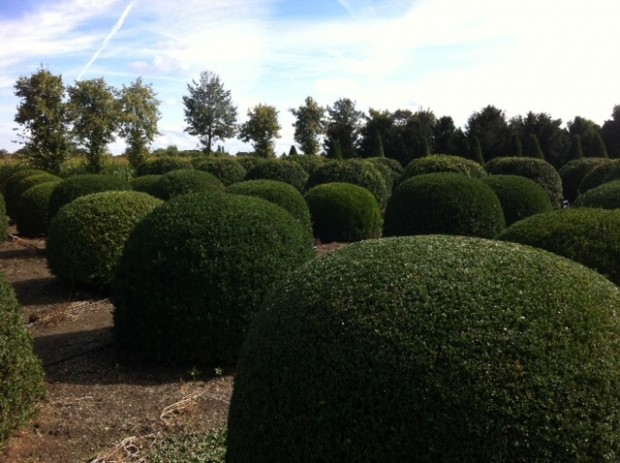
I fancy myself a gardener. That is, my life revolves around making things grow. A landscape design evolves from an idea, to a schematic plan, to a garden that gets planted. Once it is planted, there is a gardener who will see that it grows. A small tree grows up, and creates an atmosphere all its own. A perennial garden takes hold, gains weight, and blooms. Pedestrian ideas die on the vine, and are replaced by those that have lively quality to them. Those who grow-I instantly think about all of the gardeners it has been my pleasure to meet. But those who grow professionally are gardeners of a different sort. What and how they grow is not only an inspiration to gardeners. From start to finish, the life of a landscape is the story of its plants. Outstanding plants are not only irresistible, they are unforgettable.
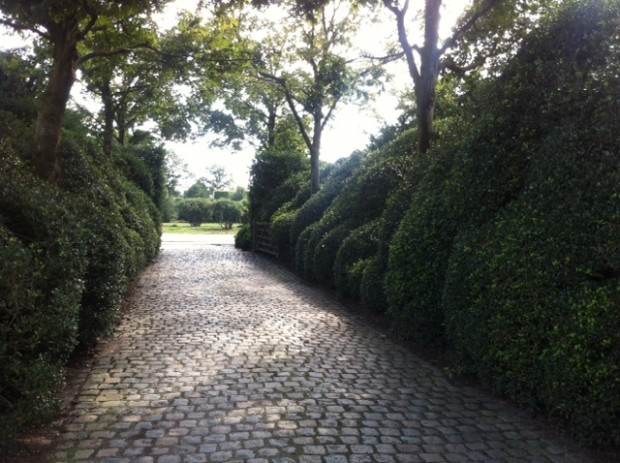
The entrance to this nursery speaks volumes to the point of view of the grower in charge. The paving stones set horizontally in the drive are an invitation, a request to slow down. The cloud-pruned yews spilling over the edges of the drive-stunning.
This nursery is devoted growing a select group of plants. Woody plant material painstakingly pruned into shapes. Not every plant responds to shearing. This gardener has a special interest in those plants that handle this kind of pruning with aplomb.
These plants are beautifully grown. They are spaced such that every one gets its fair share of sun and air. Each boxed tree matches its neighbor-the branching is the same distance from the ground from the first to the last. Each box is pruned to the same size, tree after tree. The boxwood cubes are no different. The size and shape is utterly uniform. Alternately the trees and the shrubs is not only exquisite to see, it makes the most efficient use of the space. 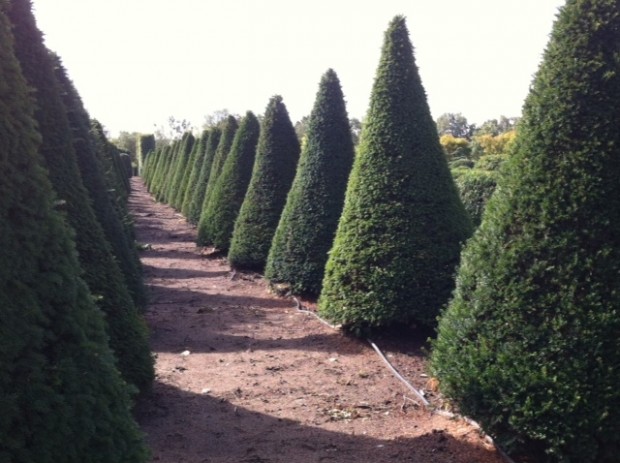
Growing yews like this takes many years, enormous skill, and incredible patience. Unlike a nursery where the stock turns over quickly, this grower has invested lots of time and a lot of land to the cultivation of a few great plants.
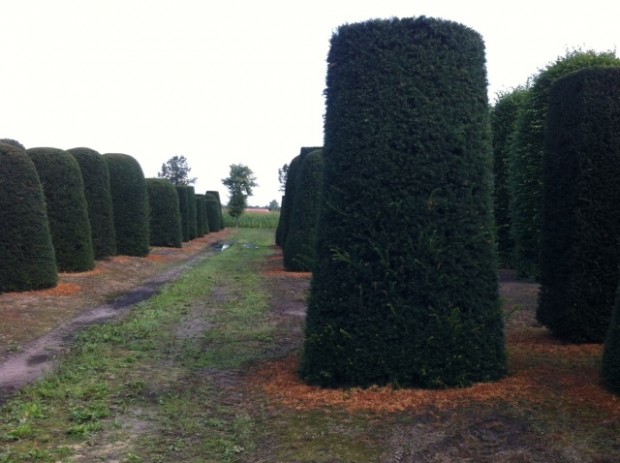
Even in climates with long growing seasons, plants of this stature take years to grow. The pruning is an ongoing process, a little at a time. The yew clippings on the ground-no longer than 6 inches. Even the clippings are uniform in shape and length.
Some of the hedging plants are grown in sections. I am sure when the section is dug, each individual plant is labelled as to its position in the row. The overall shape made by the group-striking.
A collection of individual specimen evergreens grown in boxes makes the transportation to a new home somewhat easier. Just to speculate about what one might do with one, or two, or 4 plants of this caliber-a pleasure.
These carpinus are being trained into arched shapes. The fact that they have foliage all the way to the ground suggests that the training began when they were very small plants. Trees in ground like this are regularly root pruned, which makes the task of transplanting easier. Pruning the roots means a dense fibrous mass of roots will help keep the root ball intact when a plant is dug. Though it may seen counter intuitive, moving a tree the first time is the most harrowing move of all. The roots that get cut eventually sprout multiple roots at the cut. Every successive move is easier, as the development of a dense root system aids in the transplant process.
The ability of a plant to make densely fibrous and compact rootballs plays a large part in whether it is commercially grown. Certain types of junipers are difficult to transplant, as their rootballs have a tendency to collapse. Even container grown roses need to be transplanted with great care, for the same reason. These topiaries and espaliers are grown from just a few species-yew, boxwood, carpinus, and beech.
I think all of these plants are beautifully sculptural-I would have any of them. But whether or not formally pruned trees appeal to you or not, the care, committment and vision with which they are grown is obvious. Yes, these trees are expensive-just any other gorgeous one of a kind sculpture. Where do you find trees like this? Anywhere you find a grower with a big love for growing. No small part of their beauty is how they suggest that any gardener with a small plant and an equally big love for growing could create one of their own.
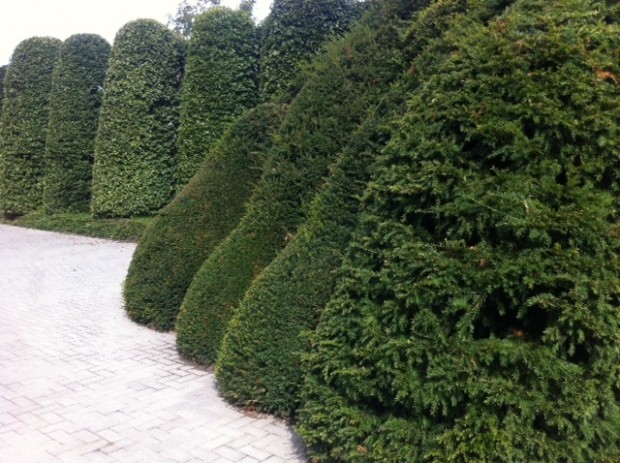
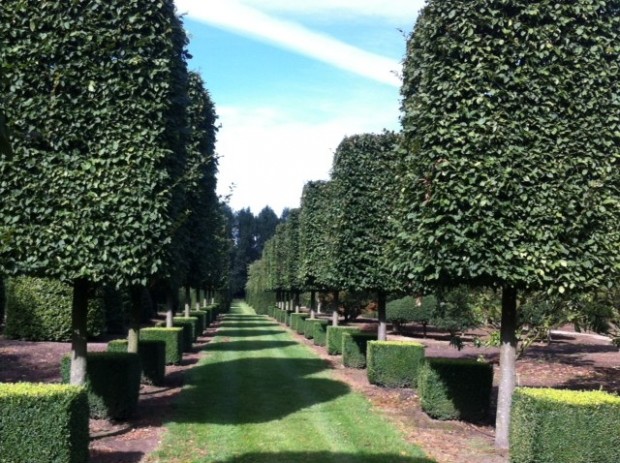
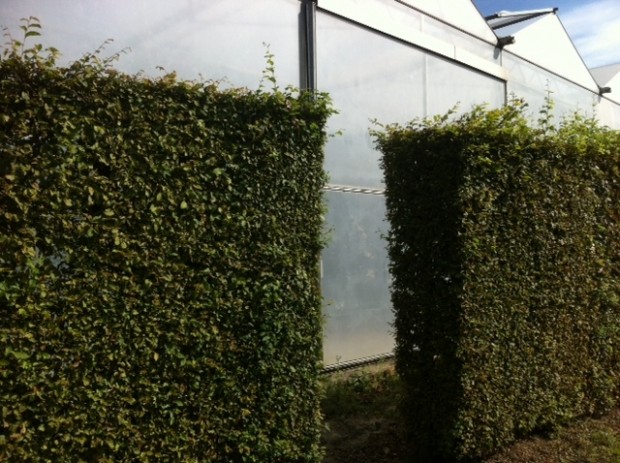
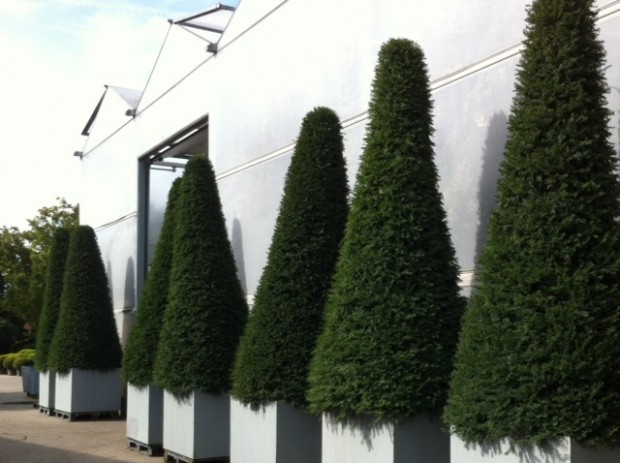
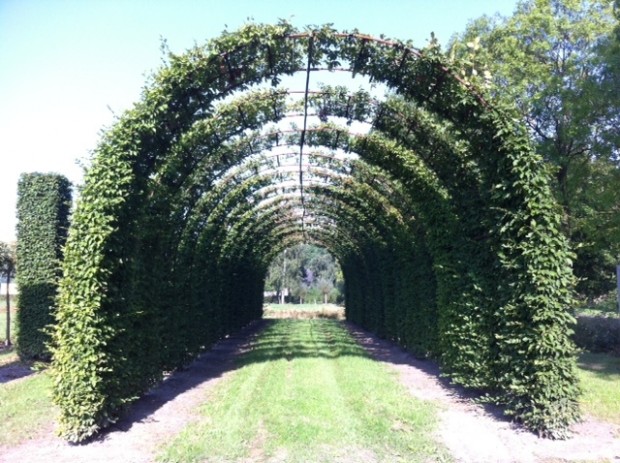
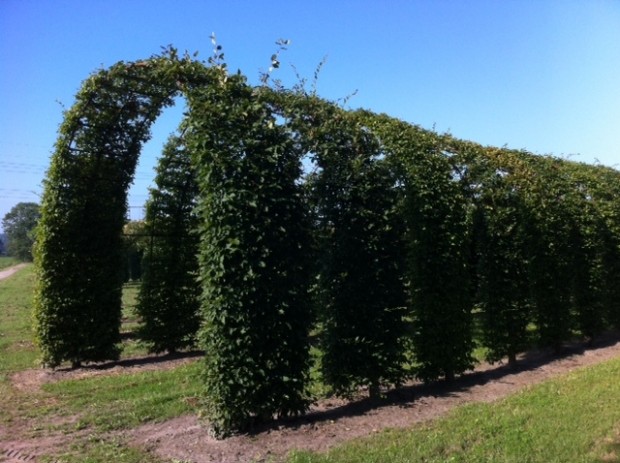
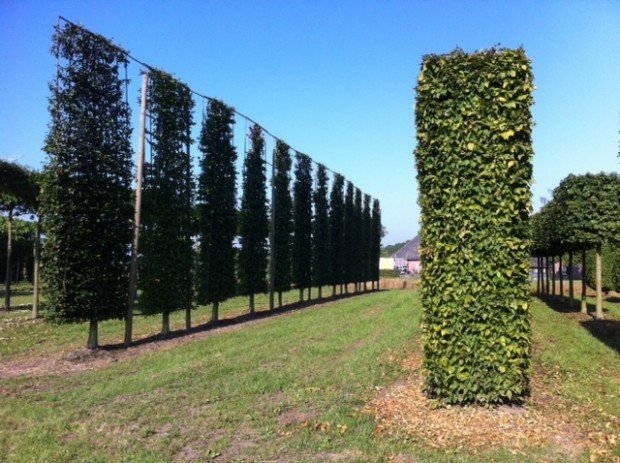
Hi Deborah,
As a rookie gardener who has spent the entire summer learning how to prudently and patiently prune/shear shrubs left behind by former owners of the property and not ever properly cared for, these images take my breath away.
The time/effort/skill that has gone into producing these magnificent specimens? I can’t even imagine. Although, as you point out, starting when the plants are small and proceeding accordingly rather than having to retrofit someone else’s “hatchet job” likely produces a better outcome, faster. Still …
Living green sculpture. Fabulous. Thank you for the beautiful inspiration!
they are gorgeous, aren’t they?
Makes me think of the great Dutch grower and designer Jacques Wirtz, whose work I have never seen but admire greatly.
Rob, great designers rely on the work of great growers. Great growers-where are they? world wide. Deborah
Better than a candy store! Every picture a more interesting and inventive pruning. Hard to even think of this as a nursery since it seems so much like a personal garden.
Dear Linda, you are right-this nursery is about a lot more than commerce.
I’m on the fence about espalier. The look is highly appealing, and is practical indeed for fruit-growing, but I wonder if we’re deforming the plant and being cruel. I have the same questions about pollarding and coppicing, though I coppice the catalpas every year. That said, the last picture in this post looks beautiful to me. Best wishes.
Dear Tom, I hate seeing plants that do not respond to that kind of pruning pruned that way anyway-as in meatball shaped burning bush, or flat topped lilacs. My idea of plant cruelty involves plants that get no care-no water, no pruning. Or trees with weed whipped trunks. These particular plants all look like they are growing for broke-I did not see one that looked “unhappy”. But that said, I know what you mean. I have the same ambivalent feeling about bonsai. Thanks for writing, Deborah
The cloud-shaped yews are indeed a copy of boxwood hedges in Jacques Wirtz’s personal garden. He is Belgian, not Dutch, and an amazing artist.
I loved looking at these pictures, they are simply breath taking. Is this nursery in Michigan?
The art of cloud pruning predates Jacques Wirtz by more than a few centuries. Someplace I read that the art was noted by Pliny in the first century AD! Some of the most beautiful examples I have seen (in pictures) are in old gardens in Japan. England and Italy have some great examples too. Our own Dunbarton Oaks in DC has some cloud pruned boxwoods that date back to the 1920’s. Jake Hobson has a great book out on pruning in this manner-and he sells great Niwaki pruning tools.
http://www.niwaki.com
Hi, Deborah.
I thought you might enjoy the slide show of these clipped conifers in a garden in Korea. http://www.flightcentre.com.au/world-travel/korea/oedo-island-paradise/information
Enjoy!
Dear Judy, many thanks for the link. This garden is extraordinary. It is amazing how many great examples of topiary art exist in so many different countries and cultures. Over centuries. Everyone defines their relationship to nature in an individual way. Those individual ways interest and enchant me. Thanks again, Deborah
I think there is a dislike for topiary and hedging in American gardens. Many reasons, most related to the scale, grandeur & natural wildness of our ‘New’ World creating an aesthic that does not accept the obviously human tended appearance of topiary, nor the enclosure of hedges. But recreating the prairie in a typical midwestern suburban property looks itsy bitsy, not grand. Well grown, well-pruned topiary, on the other hand, can add monumentality to our gardens when perfectly proportioned to enhance the home and garden. Making a mini Grand Canyon is silly, but the mass of a dense clipped tree may actually suggest grandeur in a manner which enhances the familar and human scale of our homes.
Erin, this is a very interesting take-thanks. Deborah
Wow, what a nursery. I wish this were close to the DC area, I think I’d be their best customer.
I love architectural plants. As a designer, I use perennials and grasses quite a bit, but have recently turned to highly architectural woodies as a point of contrast and focus to the looser material. I love the tension between the two. Tom Stuart-Smith in London has done some fabulous gardens that contrast sculptural hedges and topiary with naturalistic herbaceous plantings.
I enjoyed this post, as always. Thomas
Thanks, Thomas. The cool thing is that there are plants everywhere waiting to be grown/cultivated/trained in this way. I am lucky to have a company near me that does pruning of this caliber. Pruning like this can transform a beautiful plant, as you say, into a sculpture. Deborah
Hello and what a gorgeous post! I found your blog through a news story.
I fell in love with the Belgian Fences (espalier) while visiting my in-laws in that country. We have wanted to plant one for some time and especially so in the last couple of years.
Do you know if there is a grower in the Detroit metro area where we could buy what is necessary? Thank you
We have full grown Belgian fence sections for sale on occasion- usually in the spring. You can however grow your own from small whips. There are places on line that could help you with the procedure for planting one of your own from small whips. I would also look for a Michigan grower of fruit trees, who sells small stock by mail.